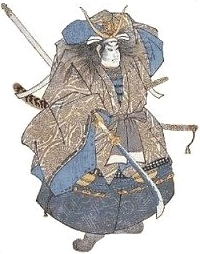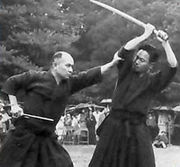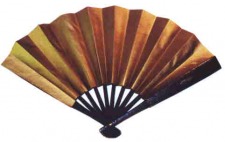Samurai Weapons

Katana- The katana is a single edged, slightly curved sword. The total length of the sword is about three foot, there are many variations. The katana is forged from two steels; one soft, one hard. These two metals are heated and folded many times, the making of a katana is an art in it self. When well made the katana is light, well balanced, strong, flexible, and resilient. The quality of the forging allows the blade to be razor sharp.
History of the Samurai Sword
ANCIENT PERIOD (Before AD 650)
Swords of this period were primarily made by Chinese and Korean masters. There aren't very many examples of these swords around today. This period marks the begining of the Japanese culture under he reign of emperor Jimmu.
NARA PERIOD (650 to 793)
The first capital city of Japan was established during this period. New laws were introduced and the imperial family established a stronghold. The need for a better equipped army started creating the need for the development of better swords.
HEIAN PERIOD (794 to 1191)
Kyoto became the capital of Japan and was ruled by the Fujirawa clan. This era produced some of the best examples of Samurai swords as new techniques were developed.
KAMAKURA PERIOD (1192 to 1336)
Feudal Japan is started. The Shogunate form of government is in place. The Mongols attempt to invade Japan and are met by Kamatura warriors who defend the island ferociously. However, their weapons are no match to the Mongol forces and are beaten. Suddenly, typhoon season starts and the mongol ships are destroyed stopping the invasion of Japan. The Kamakura warriors see the need for better swords and begin working on developing better techniques. Some of the best built swords emerge at this time. Emperor Godaigo gathers up forces and manages to overthrow the Shogunate.
MUROMACHI PERIOD (1337 to 1573)
The Shogunate returns to power. Japan is split in two as civil war erupts. The conflict lasts for over 100 years and causes a huge supply of swords to appear.
AZUCHI-MOMOYAMA PERIOD (1574 to 1602)
Japan is reunited. The existing large armies are put to use by invading China and Korea. The art of sword making continues to expand.
Tanto

Tanto - a knife, the blade is constructed much like that of a katana. It has varying lengths usually the blade is under seven inches.
History of the Tanto
Koto: Heian through Muromachi
We see the tanto begin some time in the Heian Period but was much more of a functional weapon and as a result of use few survive from this period. In the Early Kamakura Period we begin to see more tantos and the tanto begins a trend to a much more artistic weapon. The most common style is hira-tsukuri, uchi-sori. In Middle Kamakura we begin to see an abundance of tanto craftsmen, kanmuri-otoshi style seen in Yamato and Kyoto. In keeping with the style of tachi, tantos become longer and wider in the Late Kamakura period. Horimono is less decorative than religious. The new faith of Hachiman enters into carvings. The hamon of tanto are like the tachi with the exception of no choji-midare. It is not seen here. Instead, you see gunome midare and suguha. In Nambokucho, the style becomes even grander. Tanto become longer than 40 cm (beyond the normal 1 shaku) becoming like miniature wakizashi. Blades become thinner ura-to-omote but broader ha-to-mune. Two hamon styles prevail; 1) the old, fading, traditional, quiet, and 2) the new, ascending, bold and flashy such as in Soshu-den of Masamune. The Muromachi Period is ushered in, and with it comes incessant fighting. Mass production of swords spells a low point. However, custom ordered blades maintain high quality. Towards the end of this period the style of the sword shifts back to a narrower blade with shallow sori. There is also a higher frequency of very short pieces, less than five sun used as concealed daggers in robes. Generally Bizen-den and Mino-den are the most numerous smiths. Great smiths are rare in this period but include Bizen smiths Sukesada and Norimitsu. In Mino there is Kanemoto and Kanesada. In Ise we see Muramasa and Masashige. In Bungo, the Takata group is well known, and in the Northern Provinces we see the Fujishima group gain fame.
Shinto: Momoyama through early Edo
The unification of Japan brought 250 years of relative peace. This together with the change is style of wearing tachi and tanto to the wearing of katana and uchikatana (wakizashi) meant there was little call for the forging of tanto. The few that were made during the Momoyama period were copies of Nambokucho and Kamakura era works. In the Edo period, hamon become more flamboyant with billowing notare and bead-like gunome. Shapes tend to be long and slender with slight sori.
Shin-shinto: Late Edo
Still few tanto made - but more than in Shinto. Many copies of classic Kamakura, Nambokucho and Koto blades led by the influence of Suishinshi Masahide.
Naginata

Naginata is a Japanese martial art form for men, women, and children. The Naginata originated over 1,000 years ago. It was a powerful weapon against horsemen and foot soldiers alike. The Naginata's length and weight made it an efficient weapon against the sword, and its circular execution made it one of the most graceful and fluid of classical Japanese combat systems. Naginata today is an art form that teaches etiquette, respect, patience, self-confidence, and self-control. The practice of Naginata nurtures stamina, beauty and grace of movement, and the building of character through discipline and concentration. Moreover, it prepares individuals to deal with the rigors of life, and in establishing a moral code based on chivalry and honor.
Defensive Weapons

Jutte- The jutte was an iron truncheon carried by feudal era police officers called doshin, as well as by their non-samurai assistants. A late-Edo period jutte, most likely from the mid-Bakamatsu period (1853-1868) as indicated by the brass fittings. Bakamatsu translates as "Baku" (bakufu or shogunate) and "matsu" (end). The decorative jutte was probably used more for as a symbol of office rather than for actually disarming criminals. Thus, this jutte was probably carried by an aratame (official inspector) for purposes of identification.
Tessen

Folding tessen (iron fans) called a menhari-gata. These Edo Period tessen are made in the sensu-gata or basic folding fan style.The iron outer ribs of the top fan are decorated with a intricate silver inlay pattern. The lower fan is plain. The inner ribs of both are also made of iron. The fan paper professionally replaced with handmade washi by Japanese fabric artist, Miss Seiko Atsuta
